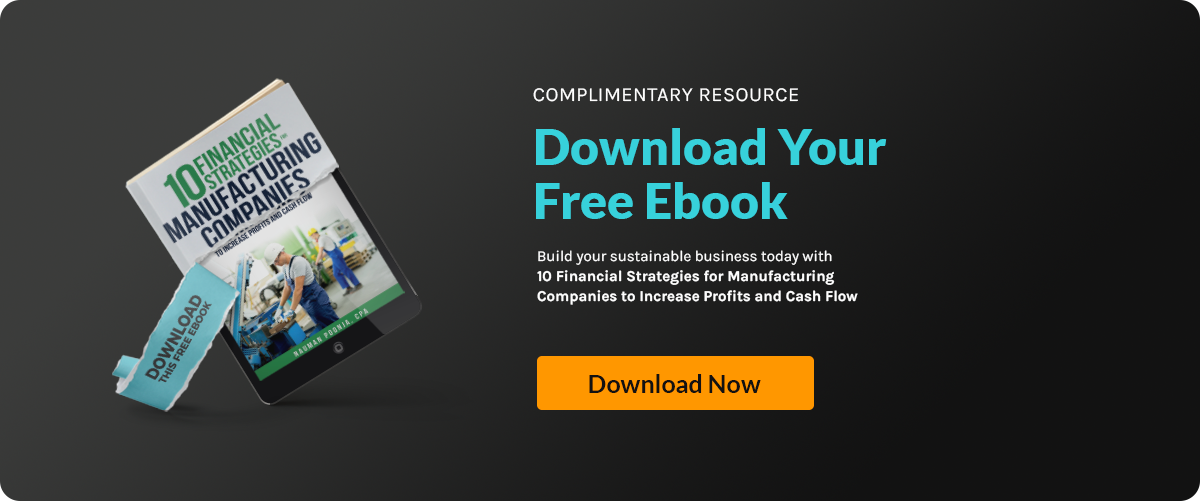Feeling like your manufacturing business is running on a treadmill, putting in all the effort but...
Why Does Capital Structure Matter for Manufacturing Growth

Growing a manufacturing business requires more than great products and efficient processes—it demands smart financial decisions, particularly in structuring your capital. This critical aspect significantly influences your company's long-term success.
A meta-analysis of 50 studies from 1998 to 2017 found that corporate performance is negatively related to capital decisions, underscoring the importance of optimal capital structure.
The proper capital structure facilitates investments in new equipment, enables strategic hiring, and provides resilience during slow periods. Conversely, poor capital decisions can leave your business well-stocked and inflexible when opportunities arise.
Read on to discover why capital structure matters and how it can fuel your manufacturing growth.
Why Does Capital Structure Matter in Manufacturing
Capital structure matters because it directly affects a company’s ability to grow, manage risk, and maintain stability. It is the mix of debt and equity used to fund a company's operations and growth. Choosing the right balance can help manufacturers reduce risks, control expenses, and improve returns.
For example, using more debt might increase leverage, boosting earnings when times are good and growing risks during downturns. In contrast, relying on more equity can mean fewer risks but may lead to a lower growth rate. A well-balanced capital structure helps manufacturers take on new projects without putting their operations at risk.
Capital Needs Assessment for Manufacturing Expansion
A solid capital structure is vital for manufacturing growth, and knowing how to assess capital needs is the first step to expanding wisely. Capital needs assessment helps manufacturers decide what resources are required for projects and what combination of funding to use.
Let's examine key factors in creating a capital needs assessment plan that aligns with the proper capital structure.
Key Factor #1 - Assess Current Resources
Start by inventorying what you already have, including existing equipment, infrastructure, and human resources. Knowing your starting point is critical to conducting a practical capital needs assessment.
Key Factor #2 - Estimate Future Investment Needs
Think ahead. Identify the investments needed to support growth, such as new machinery, facility upgrades, or an additional workforce. This will clarify how much new funding is necessary for the expansion.
Key Factor #3 - Determine Optimal Capital Structure
Determine what capital structure will fit your expansion plan. A healthy mix of debt and equity is often necessary. The capital needs assessment should align to maintain a structure that minimizes risks while supporting growth.
Key Factor #4 - Evaluate Borrowing Capacity
Look at how much debt you can take on without over-leveraging. Assessing borrowing capacity is critical in your capital needs assessment, as too much debt can make the business vulnerable to economic changes.
Key Factor #5 - Consider Market Conditions
Analyze current market conditions. Interest rates and other external factors can impact your ability to secure funding. Evaluating market conditions ensures your capital structure matters when funding expansion at a manageable cost.
Key factor #6 - Plan for Contingencies
Always include a buffer for unexpected situations. Contingencies are necessary in any capital needs assessment, allowing flexibility to handle surprises without disrupting the overall expansion plan.
Key Factor #7 - Analyze Debt vs. Equity Options
Decide whether to take on more debt or raise equity. Each option has implications for control, risk, and return. Your assessment should aim to find a balance and show why capital structure matters in achieving expansion goals.
Exploring Funding Options for Business Growth
After assessing capital needs, the next step is exploring funding options for business growth. The right funding source will support your strategy and align with your ideal capital structure. This ensures that capital structure matters in achieving growth without overextending resources. Below is a comparison of crucial funding options for business growth.
|
Funding Option |
Advantages |
Disadvantages |
|
Bank Loans |
Quick access to funds. Maintains control over company ownership. |
Requires regular interest payments. Collateral is often needed. |
|
Equity Investment |
No debt obligation. Brings investors with expertise. |
Gives up partial ownership. May lose some control over decisions. |
|
Government Grants |
No repayment is required. Encourages growth in specific industries. |
Highly competitive. Restrictions may apply on how funds are used. |
|
Retained Earnings |
No new debt or dilution of ownership. |
Limits resources that could be used elsewhere. Slower growth potential. |
Advantages and Disadvantages of Funding Options
Choosing suitable funding options for business growth is crucial. Bank loans may provide fast cash, but the downside includes interest and collateral requirements. Equity investment offers capital without debt, but owners may need to share control with investors. Government grants are ideal when available, though they can be challenging to secure and have restrictions. Retained earnings are another option, reducing the risk of debt, but they can slow down growth if resources are spread thin.
Choosing Between Short Term vs Long Term Financing
Exploring different funding options for business growth is critical to aligning with your capital structure needs. One key decision is choosing between short-term and long-term financing. Both options have unique advantages and drawbacks that directly impact how a company’s capital structure matters for its stability and growth. Here's what can help you choose the best option for you.
Short-Term Financing
Pros
Short-term financing is beneficial when manufacturers need quick access to funds. It helps solve immediate needs without locking the company into long-term obligations. This flexibility is a significant advantage, especially when tackling short-term challenges or funding opportunities with a short lifespan.
- Quick access to funds.
- There is less risk of long-term debt accumulation.
- Suitable for immediate, short-term needs.
Cons
However, short-term financing also has its risks. Payments must be made quickly, often with higher interest rates than longer-term options. This can increase the pressure on a company’s cash flow, making it less suitable for large projects or expansions.
- Requires fast repayment.
- Typically, higher interest rates.
- Limited suitability for long-term growth.
Long-Term Financing
Pros
Long-term financing provides the stability needed for significant investments and business growth. It allows companies to spread payments over time, reducing pressure on monthly cash flow. Thus, it is a fitting choice for manufacturers investing in new equipment or expanding facilities.
- Spreads repayment over more extended periods.
- Often, it has lower interest rates.
- Suitable for primary, large-scale investments.
Cons
On the downside, long-term financing requires a more profound commitment. Companies face long-term interest obligations, which become burdensome if market conditions change. Additionally, securing long-term funding often involves more requirements, such as collateral.
- Long-term debt commitments.
- Requires collateral or guarantees.
- Subject to changes in market conditions.
How to Align Your Financing Choice with Business Goals
Once you have chosen either short-term or long-term financing, aligning that decision with your business objectives is essential. Here is a step-by-step guide to help ensure your financing path effectively supports your growth strategy.
Step 1 - Assess the Impact on Current Operations
Review how the chosen financing type will affect day-to-day operations. Ensure short-term financing doesn’t strain ongoing needs or that long-term commitments don't hinder flexibility.
Step 2 - Plan for Repayment or Investment Returns
If you choose short-term financing, create a clear plan for managing repayments. If you opt for long-term funding, outline expected returns to ensure your investment will add measurable value over time.
Step 3 - Integrate with Capital Structure
Ensure your financing decision fits well with your overall structure of the capital. For stability, make adjustments to balance debt and equity for minimal risk.
Step 4 - Monitor Key Metrics Regularly
Monitor your financing effectiveness metrics, like leverage ratios or debt servicing ability. Monitoring these regularly ensures that the financing aligns with your growth goals and keeps your business on track.
Step 5 - Communicate with Stakeholders
Keep stakeholders updated. Regular updates provide clarity and transparency, building confidence in your growth strategy, whether short-term or long-term financing.
Grow Smarter, Not Harder—Team Up with Accounovation!
We know that in manufacturing, every financial decision impacts your ability to grow. A well-planned capital structure can make all the difference in securing funding, managing costs, and driving long-term success. With the right balance, growth can feel confident and easier to sustain.
At Accounovation, we help manufacturers like you develop financial strategies that support sustainable growth. From capital planning to cash flow management, we’ll guide you in building a solid foundation for your future. Let’s work together—contact us today to get started!







